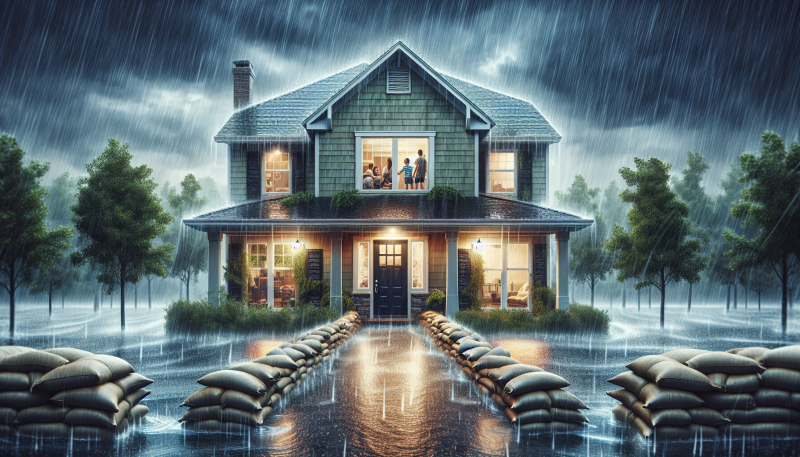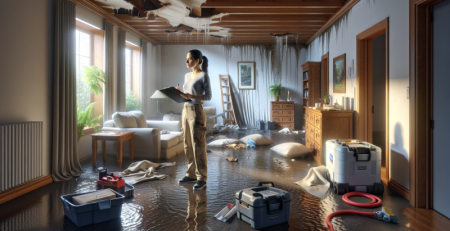How to Safeguard Your Home During Heavy Rain
Heavy rain can pose significant risks to your home, leading to potential water damage, flooding, and mold growth. As a homeowner, it’s crucial to take proactive measures to safeguard your property during these storms. At Kraus Restoration, NJ’s leaders in water damage restoration, we understand the importance of protecting your home from the elements. Our mission is to assist those who have experienced property damage due to water, flood, mold, fire, or smoke, ensuring a swift return to normalcy. In this blog, we will explore effective strategies to prevent water intrusion, manage stormwater runoff, and mitigate the risk of mold growth during heavy rainfall. With our 24/7 emergency services and a team of IICRC certified experts, we are here to provide you with the knowledge and support you need to keep your home safe and secure. Whether you’re dealing with a minor leak or a major flood, our comprehensive services are designed to address all your restoration needs. Let’s dive into the essential steps you can take to protect your home during heavy rain.
Essential Preparations Before the Storm Hits
When heavy rain is on the horizon, taking proactive steps to safeguard your home is crucial. The impact of severe weather can be devastating, leading to water damage, mold growth, and structural issues. Therefore, preparing your home before the storm hits can save you from costly repairs and ensure the safety of your family. Here are essential preparations you should consider:
First, inspect your roof for any loose or damaged shingles. A compromised roof can lead to leaks during heavy rainfall. If you notice any issues, it’s advisable to contact a professional for repairs. According to the National Roofing Contractors Association, regular roof maintenance can extend the life of your roof and prevent significant damage.
Next, clear your gutters and downspouts. Clogged gutters can cause water to overflow, leading to potential flooding around your home’s foundation. Ensure that downspouts direct water at least six feet away from your home to minimize the risk of water pooling near the foundation. The American Society of Home Inspectors recommends cleaning gutters at least twice a year, but more frequent cleaning may be necessary in areas prone to heavy rainfall.
Additionally, check your windows and doors for any gaps or cracks. Weather stripping and caulking can help seal these openings, preventing water from seeping into your home. A study by the U.S. Department of Energy indicates that proper sealing can improve energy efficiency and reduce moisture intrusion.
It’s also wise to assess your landscaping. Ensure that the grading around your home slopes away from the foundation. This will help direct rainwater away from your home and reduce the risk of flooding. If you have trees near your home, trim any branches that could potentially fall during a storm.
Consider investing in a sump pump if your home is prone to flooding. A sump pump can help remove excess water from your basement or crawl space, preventing water damage. According to the Federal Emergency Management Agency (FEMA), having a sump pump can significantly reduce the risk of basement flooding.
Another important step is to create an emergency kit. This kit should include essentials such as bottled water, non-perishable food, flashlights, batteries, a first aid kit, and important documents. The American Red Cross recommends having enough supplies to last at least three days in case of power outages or evacuation.
Furthermore, it’s essential to have a communication plan in place. Ensure that all family members know how to reach each other and where to go in case of an emergency. Keeping a list of emergency contacts, including local authorities and utility companies, can be beneficial.
Lastly, consider reviewing your insurance policy. Ensure that you have adequate coverage for flood damage, as many standard homeowner policies do not cover flooding. The National Flood Insurance Program (NFIP) offers flood insurance policies that can help protect your home and belongings.
In summary, preparing your home for heavy rain involves a combination of physical inspections, maintenance, and planning. By taking these essential steps, you can significantly reduce the risk of water damage and ensure the safety of your home and family. For more information on how to protect your home from water damage, visit our water cleanup services page or learn about our mold cleanup solutions. If you have any questions or need assistance, feel free to contact us.
Remember, preparation is key to safeguarding your home during heavy rain. Taking these steps can help you weather the storm with confidence.
Effective Strategies for Managing Water Intrusion
Managing water intrusion effectively is crucial for safeguarding your home during heavy rain. Water intrusion can lead to significant damage, including structural issues, mold growth, and compromised indoor air quality. To prevent these problems, homeowners should implement a variety of strategies that focus on both prevention and response.
First and foremost, proper drainage is essential. Ensure that your gutters and downspouts are clean and functioning correctly. Clogged gutters can overflow, directing water towards your home’s foundation. Downspouts should extend at least five to ten feet away from the foundation to prevent water from pooling around the base of your home. Additionally, consider installing gutter guards to minimize debris accumulation.
Another effective strategy is to grade your yard away from your home. The landscape should slope downward, directing rainwater away from the foundation. This can be achieved by adding soil or creating a swale, which is a shallow ditch designed to channel water away from your property. If your home is in a low-lying area, you might also want to consider installing a French drain, which can help redirect water away from your foundation.
Sealing your home is another critical step in managing water intrusion. Inspect your windows and doors for any gaps or cracks that could allow water to enter. Use caulk or weather stripping to seal these openings. Additionally, check your foundation for cracks and seal them with appropriate materials to prevent water from seeping in. If your home has a basement, ensure that it is waterproofed. This may involve applying a waterproof sealant to the walls and floor or installing a sump pump to remove any water that does enter.
Landscaping can also play a significant role in preventing water intrusion. Avoid planting trees or shrubs too close to your home, as their roots can disrupt the soil and create pathways for water to enter. Instead, create a buffer zone with gravel or other materials that can absorb water. Moreover, consider using permeable paving for driveways and walkways, which allows water to seep through rather than run off.
In the event of heavy rain, it is essential to monitor your home for signs of water intrusion. Check your basement and crawl spaces regularly for moisture or standing water. If you notice any leaks or damp spots, address them immediately to prevent further damage. Having a professional inspection can also be beneficial, as experts can identify potential vulnerabilities that you may overlook.
If water intrusion does occur, quick action is necessary to mitigate damage. Remove any standing water as soon as possible using pumps or wet vacuums. Dry out affected areas with fans and dehumidifiers to prevent mold growth. If you suspect mold has already developed, it is crucial to contact professionals who specialize in mold cleanup to ensure safe and effective removal.
In addition to these strategies, consider investing in flood insurance if you live in an area prone to heavy rain or flooding. This can provide financial protection and peace of mind in the event of significant water damage.
Lastly, staying informed about weather forecasts can help you prepare for heavy rain. If severe weather is predicted, take proactive measures such as moving valuable items to higher ground and ensuring that your drainage systems are clear and functional.
By implementing these effective strategies, you can significantly reduce the risk of water intrusion during heavy rain and protect your home from potential damage. For more information on how to safeguard your home, visit our about page or explore our services for professional assistance.
In conclusion, safeguarding your home during heavy rain is essential to protect your property and ensure the safety of your loved ones. By taking proactive measures such as inspecting and maintaining your gutters, sealing windows and doors, and ensuring proper drainage around your home, you can significantly reduce the risk of water damage. Additionally, creating an emergency plan and having necessary supplies on hand will prepare you for any unexpected weather events. Remember, a little preparation goes a long way in preserving the integrity of your home and providing peace of mind during stormy weather. Stay vigilant, stay safe, and take the necessary steps to keep your home dry and secure.










